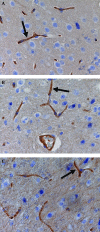Moxidectin toxicity in senescence-accelerated prone and resistant mice
- PMID: 19619412
- PMCID: PMC2733285
Moxidectin toxicity in senescence-accelerated prone and resistant mice
Abstract
Moxidectin has been used safely as an antiparasitic in many animal species, including for the eradication of the mouse fur mite, Mycoptes musculinus. Although no side effects of moxidectin have previously been reported to occur in mice, 2 strains of the senescence-accelerated mouse (SAMP8 and SAMR1) sustained considerable mortality after routine prophylactic treatment. To investigate the mechanism underlying this effect, moxidectin toxicosis in these mice was evaluated in a controlled study. Moxidectin was applied topically (0.015 mg), and drug concentrations in both brain and serum were analyzed by using HPLC coupled with mass spectrometry. The moxidectin concentration in brain of SAMP8 mice was 18 times that in controls, and that in brain of SAMR1 mice was 14 times higher than in controls, whereas serum moxidectin concentrations did not differ significantly among the 3 strains. Because deficiency of the blood-brain barrier protein P-glycoprotein leads to sensitivity to this class of drugs in other SAM mice, Pgp immunohistochemistry of brain sections from a subset of mice was performed to determine whether this commercially available analysis could predict sensitivity to this class of drug. The staining analysis showed no difference among the strains of mice, indicating that this test does not correlate with sensitivity. In addition, no gross or histologic evidence of organ toxicity was found in brain, liver, lung, or kidney. This report shows that topically applied moxidectin at a standard dose accumulates in the CNS causing toxicosis in both SAMP8 and SAMR1 mice.
Figures


Similar articles
-
Abcb1a and Abcb1b expression in senescence-accelerated mouse (SAM).Neurosci Lett. 2009 May 29;456(1):34-8. doi: 10.1016/j.neulet.2009.03.067. Epub 2009 Mar 27. Neurosci Lett. 2009. PMID: 19429129
-
Role of P-glycoprotein in the disposition of macrocyclic lactones: A comparison between ivermectin, eprinomectin, and moxidectin in mice.Drug Metab Dispos. 2010 Apr;38(4):573-80. doi: 10.1124/dmd.109.030700. Epub 2010 Jan 20. Drug Metab Dispos. 2010. PMID: 20089736
-
Time-course of blood-brain barrier disruption in senescence-accelerated mouse prone 8 (SAMP8) mice.Int J Dev Neurosci. 2009 Feb;27(1):47-52. doi: 10.1016/j.ijdevneu.2008.10.002. Epub 2008 Oct 17. Int J Dev Neurosci. 2009. PMID: 18992318
-
Toxicology of Avermectins and Milbemycins (Macrocyclic Lactones) and the Role of P-Glycoprotein in Dogs and Cats.Vet Clin North Am Small Anim Pract. 2018 Nov;48(6):991-1012. doi: 10.1016/j.cvsm.2018.07.002. Epub 2018 Aug 21. Vet Clin North Am Small Anim Pract. 2018. PMID: 30139545 Review.
-
Age-related defects in lifespan and learning ability in SAMP8 mice.Neurobiol Aging. 1999 Mar-Apr;20(2):111-5. doi: 10.1016/s0197-4580(99)00006-8. Neurobiol Aging. 1999. PMID: 10537020 Review.
Cited by
-
An improved ivermectin-activated chloride channel receptor for inhibiting electrical activity in defined neuronal populations.J Biol Chem. 2010 May 14;285(20):14890-14897. doi: 10.1074/jbc.M110.107789. Epub 2010 Mar 22. J Biol Chem. 2010. PMID: 20308070 Free PMC article.
-
Safety and efficacy of topical lime sulfur in mice infested with Myocoptes musculinus.J Am Assoc Lab Anim Sci. 2013;52(3):259-64. J Am Assoc Lab Anim Sci. 2013. PMID: 23849408 Free PMC article. Clinical Trial.
-
Ivermectin-compounded Feed Compared with Topical Moxidectin-Imidacloprid for Eradication of Demodex musculi in Laboratory Mice.J Am Assoc Lab Anim Sci. 2018 Sep 1;57(5):483-497. doi: 10.30802/AALAS-JAALAS-18-000003. Epub 2018 Sep 5. J Am Assoc Lab Anim Sci. 2018. PMID: 30185284 Free PMC article.
-
Effect of sampling strategy on the detection of fur mites within a naturally infested colony of mice (Mus musculus).J Am Assoc Lab Anim Sci. 2011 May;50(3):337-43. J Am Assoc Lab Anim Sci. 2011. PMID: 21640028 Free PMC article.
-
Drug dose and animal welfare: important considerations in the treatment of wildlife.Parasitol Res. 2022 Mar;121(3):1065-1071. doi: 10.1007/s00436-022-07460-4. Epub 2022 Feb 11. Parasitol Res. 2022. PMID: 35147771 Free PMC article.
References
-
- Baars C, Leeb T, von Klopmann T, Tipold A, Potschka H. 2008. Allele-specific polymerase chain reaction diagnostic test for the functional MDR1 polymorphism in dogs. Vet J 177:394–397 - PubMed
-
- Banks WA, Moinuddin A, Morley JE. 2001. Regional transport of TNFα across the blood-brain barrier in young ICR and young and aged SAMP8 mice. Neurobiol Aging 22:671–676 - PubMed
-
- Beal MW, Poppenga RH, Birdsall WJ, Hughes D. 1999. Respiratory failure attributable to moxidectin intoxication in a dog. J Am Vet Med Assoc 215:1813–1817 - PubMed
MeSH terms
Substances
LinkOut - more resources
Full Text Sources
Miscellaneous
